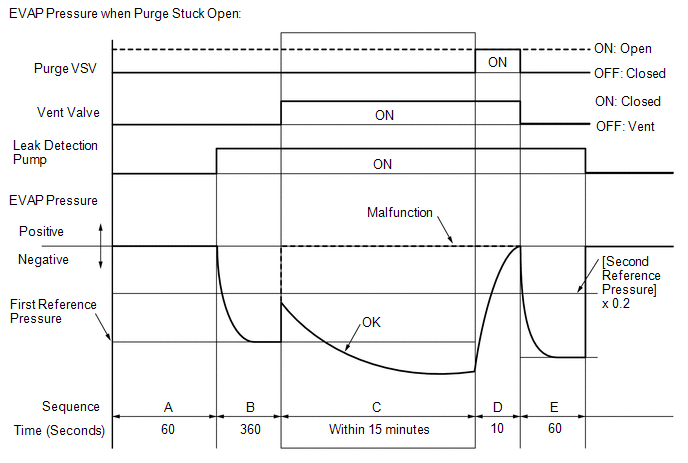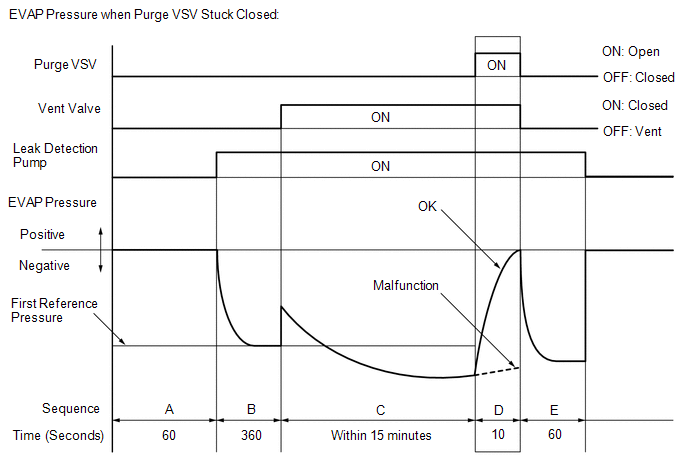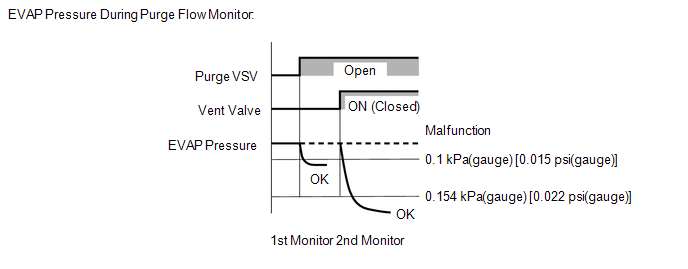Lexus RX (RX 350L, RX450h) 2016-2025 Repair Manual: Evaporative Emission System Incorrect Purge Flow Actuator Stuck On (P04417E,P04417F,P04419C)
DTC SUMMARY
| DTC No. | Detection Item | DTC Detection Condition | Trouble Area | MIL | Memory | Note |
|---|---|---|---|---|---|---|
| P04417E | Evaporative Emission System Incorrect Purge Flow Actuator Stuck On | Leak detection pump creates negative pressure (vacuum) in EVAP system and EVAP system pressure measured. Reference pressure is measured at start and at end of leak check. If stabilized pressure higher than [second reference pressure x 0.2], ECM determines that purge VSV stuck open. |
| Comes on | DTC stored | SAE Code: P0441 |
| P04417F | Evaporative Emission System Incorrect Purge Flow Actuator Stuck Off | After EVAP leak check performed, purge VSV turned on (open), and atmospheric air introduced into EVAP system. Reference pressure is measured at start and at end of check. If pressure does not return to near atmospheric pressure, ECM determines that purge VSV stuck closed. |
| Comes on | DTC stored | SAE Code: P0441 |
| P04419C | Evaporative Emission System Incorrect Purge Flow Low/Insufficient Flow | While engine running, following conditions successively met:
|
| Comes on | DTC stored | SAE Code: P0441 |
| DTC No. | Monitoring Item | Detection Timing | Detection Logic | SAE |
|---|---|---|---|---|
| P04417E | Purge VSV (Vacuum Switching Valve) stuck open | EVAP monitoring (engine switch off) | 2 trip | P0441 |
| P04417F | Purge VSV stuck closed | EVAP monitoring (engine switch off) | 2 trip | P0441 |
| P04419C | Purge flow | Engine running | 2 trip | P0441 |
DESCRIPTION
The description can be found in EVAP (Evaporative Emission) System.
Click here .gif)
MONITOR DESCRIPTION
The 2 monitors, Key-off and purge flow, are used to detect malfunctions relating to DTCs P04417E, P04417F and P04419C. The Key-Off monitor is initiated by the ECM internal timer, known as the soak timer, 5 hours after the engine switch is turned off. The purge flow monitor runs while the engine is running.
-
KEY-OFF MONITOR
5 hours* after the engine switch is turned off, the electric leak detection pump creates negative pressure (vacuum) in the EVAP (Evaporative Emission) system. The ECM monitors for leaks and actuator malfunctions based on the EVAP pressure.
HINT:
*: If the engine coolant temperature is not less than 35°C (95°F) 5 hours after the engine switch is turned off, the monitor check starts 2 hours later. If it is still not less than 35°C (95°F) 7 hours after the engine switch is turned off, the monitor check starts 2.5 hours later.
Sequence
Operation
Description
Duration
-
ECM activation
Activated by soak timer 5, 7 or 9.5 hours after engine switch turned off.
-
A
Atmospheric pressure measurement
Vent valve is turned off (vent) and EVAP system pressure is measured by ECM in order to register atmospheric pressure.
If pressure in EVAP system is not between 70 kPa(abs) and 110 kPa(abs) [10.15 psi(abs) and 15.95 psi(abs)], ECM cancels EVAP system monitor.
60 seconds
B
First reference pressure measurement
In order to determine reference pressure, leak detection pump creates negative pressure (vacuum) through reference orifice and then ECM checks if leak detection pump and vent valve operate normally.
360 seconds
C
EVAP system pressure measurement
Vent valve is turned on (closed) to shut EVAP system.
Negative pressure (vacuum) is created in EVAP system, and EVAP system pressure is then measured.
Write down measured value as it will be used in leak check.
If EVAP pressure does not stabilize within 15 minutes, ECM cancels EVAP system monitor.
15 minutes*
D
Purge VSV monitor
Purge VSV opened and then EVAP system pressure is measured by ECM.
A large increase indicates normality.
10 seconds
E
Second reference pressure measurement
After second reference pressure measurement, leak check is performed by comparing first and second reference pressure measurements.
If stabilized system pressure is higher than second reference pressure, ECM determines that EVAP system leaking.
60 seconds
-
Final check
Atmospheric pressure is measured and then monitoring result is recorded by ECM.
-
*: If only a small amount of fuel is in the fuel tank, it takes longer for the EVAP pressure to stabilize.
.png)
*1
Purge VSV: Off (Closed)
*2
Purge VSV: On (Open)
*3
Vent Valve: Off (Vent)
*4
Vent Valve: On (Closed)
*5
Leak Detection Pump: Off
*6
Leak Detection Pump: On
*7
Reference Orifice (0.02 inch)
*8
Canister Pressure Sensor
*9
Canister
*10
Fuel Tank
*11
Canister Pump Module
*12
Canister Filter
*a
Operation A:
Atmospheric Pressure Measurement
*b
Operation B, E:
Reference Pressure Measurement
*c
Operation C:
EVAP System Pressure Measurement
*d
Operation D:
Purge VSV Monitor
*e
Atmospheric Pressure
*f
Negative Pressure
-
Purge VSV stuck open
In operation C, the leak detection pump creates negative pressure (vacuum) in the EVAP (Evaporative Emission) system. The EVAP system pressure is then measured by the ECM using the canister pressure sensor. If the stabilized system pressure is higher than [second reference pressure x 0.2], the ECM interprets this as the purge VSV being stuck open. If any deterioration has occurred, the ECM will illuminate the MIL and store DTC P04417E (2 trip detection logic).

-
Purge VSV stuck closed
In operation D, the canister pressure sensor measures the EVAP (Evaporative Emission) system pressure. The pressure measurement for the purge VSV monitor begins when the purge VSV is turned on (open) after the EVAP leak check. When the measured pressure indicates an increase of 0.3 kPa(gauge) [0.044 psi(gauge)] or higher, the purge VSV is functioning normally. If the pressure does not increase, the ECM interprets this as the purge VSV being stuck closed, illuminates the MIL and store DTC P04417F (2 trip detection logic).

-
Purge VSV stuck open
-
PURGE FLOW MONITOR
The purge flow monitor consists of 2 monitors. The 1st monitor is conducted every time and the 2nd monitor is activated if necessary.

-
The 1st monitor
While the engine is running and the purge VSV is on (open), the ECM monitors the purge flow by measuring the EVAP pressure change. If negative pressure is not created, the ECM begins the 2nd monitor.
-
The 2nd monitor
The vent valve is turned on (closed) and the EVAP pressure is then measured. If the variation in the pressure is less than 0.154 kPa(gauge) [0.022 psi(gauge)], the ECM interprets this as the purge VSV being stuck closed, illuminates the MIL and stores DTC P04419C (2 trip detection logic).
Atmospheric pressure check:
In order to ensure reliable malfunction detection, the variation in atmospheric pressures, before and after conduction of the purge flow monitor, is measured by the ECM.
MONITOR STRATEGY
| Required Sensors/Components (Main) | Purge VSV Canister pump module |
| Required Sensors/Components (Related) | - |
| Frequency of Operation | Once per driving cycle |
| Duration | Within 20 minutes: Purge VSV stuck open/close Less than 30 seconds: Purge flow |
| MIL Operation | 2 driving cycles |
| Sequence of Operation | None |
TYPICAL ENABLING CONDITIONS
All| Monitor runs whenever the following DTCs are not stored | None |
| Atmospheric pressure | 70 kPa(abs) [10.15 psi(abs)] or higher, and less than 110 kPa(abs) [15.95 psi(abs)] |
| Battery voltage | 10.5 V or higher |
| Vehicle speed | Less than 4 km/h (2.5 mph) |
| Engine switch | Off |
| Time after key-off | 5, 7 or 9.5 hours |
| EVAP pressure sensor malfunction (P0452, P0453) | Not detected |
| Purge VSV | Not operated by scan tool |
| Vent valve | Not operated by scan tool |
| Leak detection pump | Not operated by scan tool |
| Both of the following conditions met before key-off | 1 and 2 |
| 1. Duration that vehicle is driven | 5 minutes or more |
| 2. EVAP purge operation | Performed |
| Engine coolant temperature | 4.4°C (40°F) or higher, and less than 35°C (95°F) |
| Intake air temperature | 4.4°C (40°F) or higher, and less than 35°C (95°F) |
| Engine | Running |
| Engine coolant temperature | 4.4°C (40°F) or higher |
| Intake air temperature | 4.4°C (40°F) or higher |
| Canister pressure sensor malfunction (P0451, P0452, P0453) | Not detected |
| Purge VSV | Not operated by scan tool |
| EVAP system check | Not operated by scan tool |
| Battery voltage | 10 V or higher |
| Purge duty-cycle | 8% or higher |
TYPICAL MALFUNCTION THRESHOLDS
Purge VSV Stuck Open| EVAP pressure when vacuum introduction is complete | Higher than [reference pressure x 0.2] |
| EVAP pressure change for 10 seconds after purge VSV ON (open) | Less than 0.3 kPa(gauge) [0.044 psi(gauge)] |
| Both of the following conditions are met: | 1 and 2 |
| 1. EVAP pressure change when purge flow is started | Less than 0.1 kPa(gauge) [0.015 psi(gauge)] |
| 2. EVAP pressure change during purge operation when vent valve on (closed) | Less than 0.154 kPa(gauge) [0.022 psi(gauge)] |
MONITOR RESULT
Refer EVAP System.
Click here .gif)
CONFIRMATION DRIVING PATTERN
NOTICE:
- The Evaporative System Check (Automatic Mode) consists of 6 steps performed automatically by the Techstream. It takes a maximum of approximately 24 minutes.
- Do not perform the Evaporative System Check when the fuel tank is higher than 85% full because the cut-off valve may be closed, making the fuel tank leak check unavailable.
- Do not run the engine during this operation.
- When the temperature of the fuel is 35°C (95°F) or higher, a large amount of vapor forms and any check results become inaccurate. When performing the Evaporative System Check, keep the fuel temperature less than 35°C (95°F).
HINT:
-
After repair has been completed, clear the DTC and then check that the vehicle has returned to normal by performing the following All Readiness check procedure.
Click here
.gif)
-
When clearing the permanent DTCs, refer to the "CLEAR PERMANENT DTC" procedure.
Click here
.gif)
- Connect the Techstream to the DLC3.
- Turn the engine switch on (IG).
- Turn the Techstream on.
- Clear the DTCs (even if no DTCs are stored, perform the clear DTC procedure).
- Turn the engine switch off and wait for at least 30 seconds.
- Turn the engine switch on (IG) [A].
- Turn the Techstream on.
- Enter the following menus: Powertrain / Engine / Utility / Evaporative System Check / Automatic Mode [B].
- After the Evaporative System Check is completed, check for All Readiness by entering the following menus: Powertrain / Engine / Utility / All Readiness.
- Input the DTC: P04417E or P04417F.
-
Check the DTC judgment result.
Techstream Display
Description
NORMAL
- DTC judgment completed
- System normal
ABNORMAL
- DTC judgment completed
- System abnormal
INCOMPLETE
- DTC judgment not completed
- Perform driving pattern after confirming DTC enabling conditions
HINT:
- If the judgment result is NORMAL, the system is normal.
- If the judgment result is ABNORMAL, the system is malfunctioning.
-
[A] to [B]: Normal judgment procedure.
The normal judgment procedure is used to complete DTC judgment and also used when clearing permanent DTCs.
- When clearing the permanent DTCs, do not disconnect the cable from the battery terminal or attempt to clear the DTCs during this procedure, as doing so will clear the universal trip and normal judgment histories.
- Connect the Techstream to the DLC3.
- Turn the engine switch on (IG).
- Turn the Techstream on.
- Clear the DTCs (even if no DTCs are stored, perform the clear DTC procedure).
- Turn the engine switch off and wait for at least 30 seconds.
- Start the engine and wait 15 minutes or more [A].
- Turn the Techstream on.
- Enter the following menus: Powertrain / Engine / Trouble Codes [B].
-
Read the pending DTCs.
HINT:
- If a pending DTC is output, the system is malfunctioning.
- If a pending DTC is not output, perform the following procedure.
- Enter the following menus: Powertrain / Engine / Utility / All Readiness.
- Input the DTC: P04419C.
-
Check the DTC judgment result.
Techstream Display
Description
NORMAL
- DTC judgment completed
- System normal
ABNORMAL
- DTC judgment completed
- System abnormal
INCOMPLETE
- DTC judgment not completed
- Perform driving pattern after confirming DTC enabling conditions
HINT:
- If the judgment result is NORMAL, the system is normal.
- If the judgment result is ABNORMAL, the system is malfunctioning.
-
[A] to [B]: Normal judgment procedure.
The normal judgment procedure is used to complete DTC judgment and also used when clearing permanent DTCs.
- When clearing the permanent DTCs, do not disconnect the cable from the battery terminal or attempt to clear the DTCs during this procedure, as doing so will clear the universal trip and normal judgment histories.
PROCEDURE
| 1. | GO TO EVAP SYSTEM |
(a) Refer to EVAP System.
Click here .gif)
| NEXT | .gif) | END |
 Catalyst System Efficiency Below Threshold Bank 1 (P042000,P043000)
Catalyst System Efficiency Below Threshold Bank 1 (P042000,P043000)
MONITOR DESCRIPTION The ECM uses sensors mounted in front of and behind the Three-Way Catalytic Converter (TWC) to monitor its efficiency. The first sensor, the air fuel ratio sensor, sends pre-cataly ...
 Evaporative Emission System Pressure Sensor/Switch Circuit Short to Ground (P045011,P045015,P04502A,P04502F)
Evaporative Emission System Pressure Sensor/Switch Circuit Short to Ground (P045011,P045015,P04502A,P04502F)
DTC SUMMARY DTC No. Detection Item DTC Detection Condition Trouble Area MIL Memory Note P045011 Evaporative Emission System Pressure Sensor/Switch Circuit Short to Ground EVAP p ...
Other materials:
Lexus RX (RX 350L, RX450h) 2016-2025 Repair Manual > Parking Brake: Parking Brake System
PrecautionPRECAUTION NOTICE:
If the battery is connected, the parking brake will operate when the electric parking brake switch assembly is pulled to the lock side even if the engine switch is off, Do not operate the electric parking brake switch assembly with the battery connected unless specifi ...
Lexus RX (RX 350L, RX450h) 2016-2025 Repair Manual > Navigation System: Touch Pad Sensor Malfunction (B1559)
DESCRIPTION This DTC is stored if the remote touch (remote operation controller assembly) detects a malfunction in itself, such as internal hardware failure or remote touch screen sensor malfunction. DTC No. Detection Item DTC Detection Condition Trouble Area B1559 Touch Pad Sensor Ma ...
Lexus RX (RX 350L, RX450h) 2016-{YEAR} Owners Manual
- For your information
- Pictorial index
- For safety and security
- Instrument cluster
- Operation of each component
- Driving
- Lexus Display Audio system
- Interior features
- Maintenance and care
- When trouble arises
- Vehicle specifications
- For owners
Lexus RX (RX 350L, RX450h) 2016-{YEAR} Repair Manual
0.018
